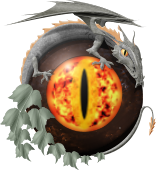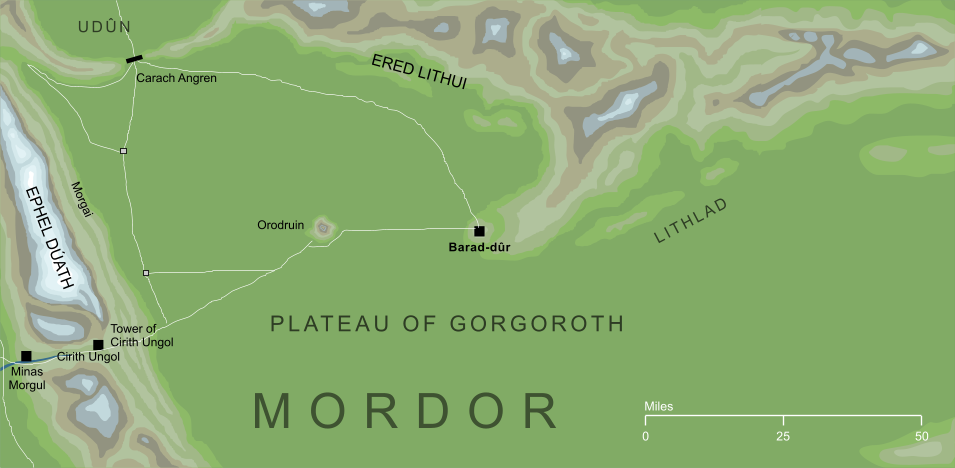- Cities and buildings
- Fields, plains and deserts
- Forests
- Hills and mountains
- Islands and promontories
- Lands, realms and regions
- Rivers and lakes
- Seas and oceans


 |
||
|


Which personality type are you?
Take the Free mydiscprofile Personality Test to discover your core personality and your ideal job.   Which personality type are you? |
|
Dates
First built between c. II 1000 and c. II 1600; destroyed in II 3441; rebuilding began in III 2951; finally destroyed in III 3019
Location
On an outcrop of Ered Lithui, in the northwest of Mordor
Origins
Race
Division
Pronunciation
ba'rad doorr (the final 'r' should be pronounced - 'rr' is used here to emphasise this)
Meaning
Other names
Indexes: About this entry:
|
Barad-dûrThe Dark Tower of Sauron
"...wall upon wall, battlement upon battlement, black, immeasurably strong, mountain of iron, gate of steel, tower of adamant ... Barad-dûr, Fortress of Sauron."
The Fellowship of the Ring II 10
The Breaking of the Fellowship The mighty Shadow-shrouded stronghold of Sauron in the Second and Third Ages. The First Building of Barad-dûrThe first building of Barad-dûr, when Sauron first came to Mordor, took six hundred years to complete. Soon after, Tar-Minastir of Númenor sent a fleet to Middle-earth, and Sauron's forces were driven out of the western lands that they had roamed at will to that time. Barad-dûr could not be approached by the Númenóreans, however, and Sauron was able to consolidate his power and extend it into the east. In II 3262, Sauron left his Dark Tower to travel to Númenor with the vast forces of Ar-Pharazôn, but he returned after the Downfall of Númenor in II 3319. The Last Alliance besieged Barad-dûr in II 3434, and the Tower was taken and destroyed by the forces of Elendil and Gil-galad, who both perished in the siege, in II 3441. Though the tower of Barad-dûr was levelled to the ground, its foundations had been made with the power of the Ring, and could not be destroyed. The Second Building of Barad-dûrFor much of the Third Age, Sauron's stronghold was not in Mordor, which was ruled in his stead by the Nazgûl. Rather, the Dark Lord dwelt in the south of Mirkwood at Dol Guldur. In III 2941, the White Council sent their forces to drive him from Mirkwood, and he withdrew to Mordor once again. There, he began the rebuilding of the Dark Tower. Given that the Tower originally took some six hundred years to raise, it seems surprising that its second building can have taken no more than a few decades. This is perhaps partly explained by the fact that its foundations, laid with the power of the Ring, remained in Gorgoroth ready to be built upon. Barad-dûr was constructed as much through the personal power of Sauron as through stone and mortar; when the One Ring was destroyed in Orodruin, this power was lost and the Tower destroyed forever. The Appearance of Barad-dûrThe most complete description we have of Barad-dûr is that given in the quote at the head of this page. We know, then, that it was black, and constructed mainly of metal. 'Adamant' usually refers to diamond, but it is hard to imagine Sauron adding diamond towers to his dark fortress - in this context, it probably has the more general meaning of 'hard, unbreakable substance'. From the steel gate of the Tower, a causeway ran out into the plain of Gorgoroth, across a mighty bridge. We also know that lava from Mount Doom was channeled back across that plain to Barad-dûr. Tolkien probably leaves details of the Tower's construction vague intentionally, as it was hidden by a cloud of shadow and darkness at all times. Frodo and Sam saw Barad-dûr as they journeyed to Mount Doom: '...rising black, blacker and darker than the vast shades amid which it stood, the cruel pinnacles and iron crown of the topmost tower of Barad-dûr...' (The Lord of the Rings 6 III: Mount Doom). The 'topmost tower of Barad-dûr' seems to have been the place where Sauron dwelt. At least, the Window of the Eye, from which the Lidless Eye stared out across Middle-earth, was located there. See also...Ash Mountains, Battle of Dagorlad, Black Pit, Black Pits, Black Speech, Chambers of Fire, Dark Lord, Dark Throne, Dark Tower, Downfall of Barad-dûr, Elendil, Elves of Lindon, Ered Lithui, Eye of Barad-dûr, Eye of Mordor, [See the full list...] Indexes: About this entry:
For acknowledgements and references, see the Disclaimer & Bibliography page. Original content © copyright Mark Fisher 1997-2000, 2008. All rights reserved. For conditions of reuse, see the Site FAQ. Website services kindly sponsored by myDISCprofile, the free online personality test.Take the FREE myDISCprofile personality test to discover your core personality and your ideal job. |